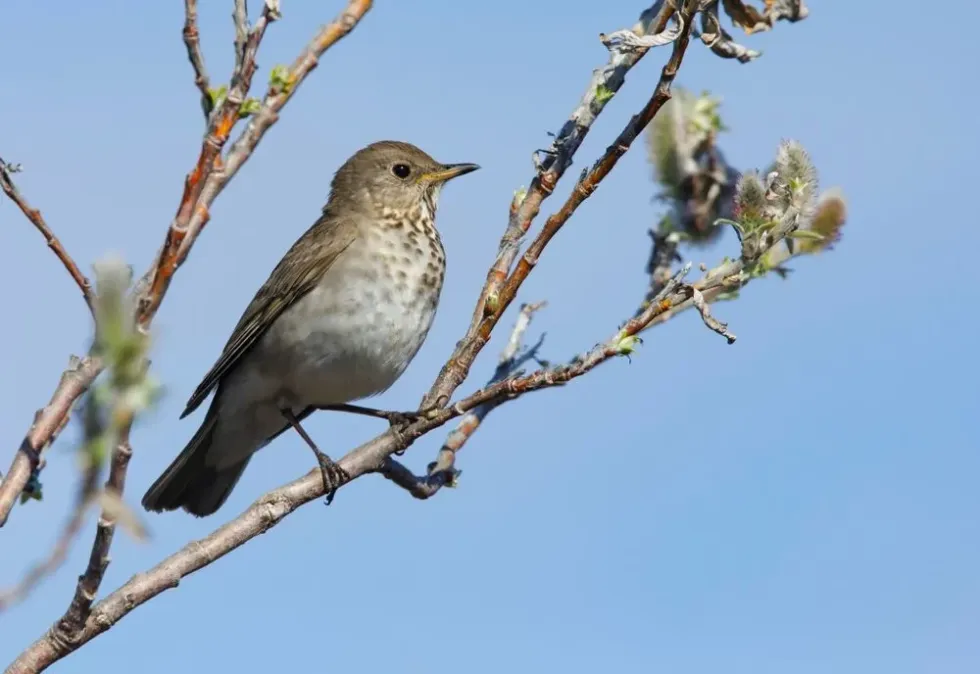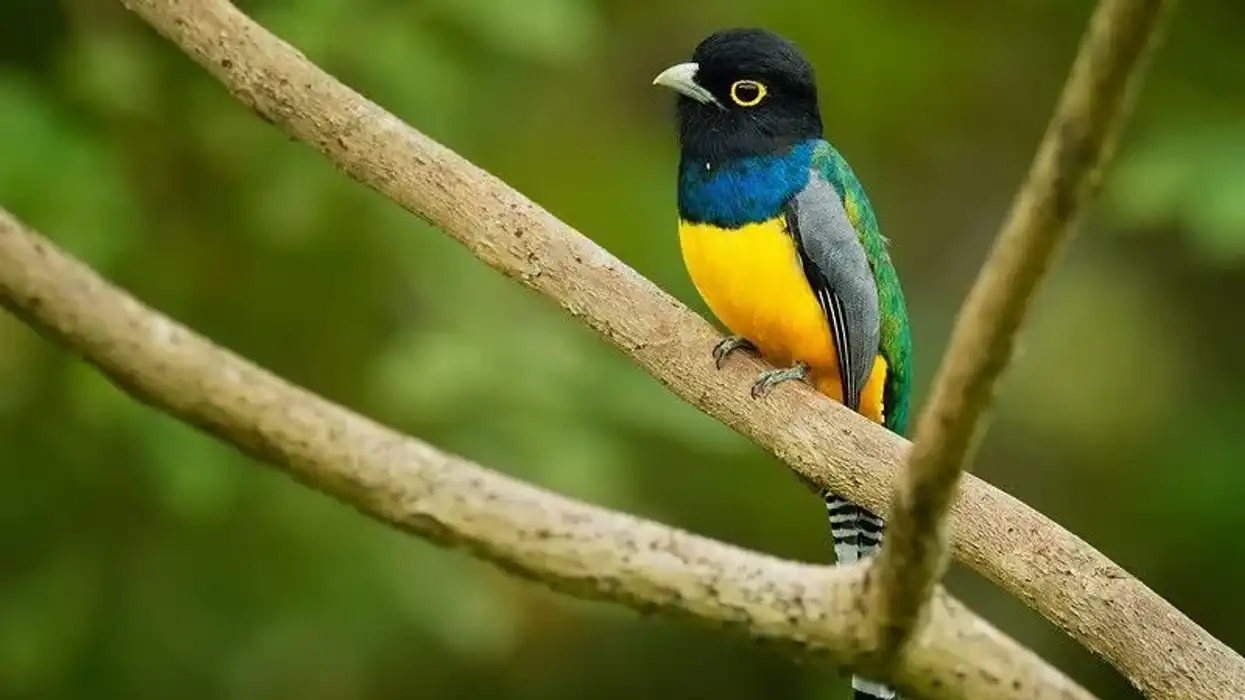Do you like learning about different types of birds, from the wood thrush to the waterthrush? Then you should give this article on the gray-cheeked thrush a read!
The gray-cheeked thrush is a migratory species of birds belonging to the genus Catharus. These birds migrate twice a year, during spring and fall.
They have been classified into two subspecies: the northern gray-cheeked thrush and the Newfoundland gray-cheeked thrush. Both species can be separated based on their breeding range and appearance.
The preferred habitat of this bird includes boreal forests characterized by coniferous trees and cold winters. They can be distinguished from Swainson's thrushes, another species of the same family, by their gray faces and the absence of a buffy eye-ring.
The breeding season of these birds ranges from May to August. Their breeding range is located in North America. After mating, the female bird lays around four eggs and incubates them for 12-14 days.
Their eggs are pale blue with brown spots and both parents are involved in parental care. The young birds leave the nest after a span of 11-13 days after hatching.
The International Union for Conservation of Nature (IUCN) Red List has listed the gray-cheeked thrush as a species of Least Concern. Their range located in North America can be greatly affected and perhaps even lost due to rising temperatures. Read on to know more about these birds of North America.
If you liked reading this article, then do check out these Cape starling and Gloster canary facts.
Gray-Cheeked Thrush Interesting Facts
What type of animal is a gray-cheeked thrush?
The gray-cheeked thrush is a species of North American birds that belongs to the order Passeriformes, family Turdidae, and genus Catharus. It consists of two subspecies: the northern gray-cheeked thrush (Catharus minimus alicia) and the Newfoundland gray-cheeked thrush (Catharus minimus minimus).
What class of animal does a gray-cheeked thrush belong to?
These birds belong to the class Aves along with all species of thrush birds. Its scientific name is Catharus minimus.
How many gray-cheeked thrushes are there in the world?
The total number of mature individuals present in the world is around 12,000,000, according to the IUCN Red List.
Where does a gray-cheeked thrush live?
The gray-cheeked thrush range extends from the northeastern part of Siberia to Alaska in the United States and northern Canada. Their breeding range extends from Yukon territory in the north, across Labrador to Ungava Bay.
Their range includes British Columbia, Quebec, Newfoundland, northern Alberta, and Manitoba in the south. They are found in North America during the breeding season and they migrate to the warmer South America during the winter season. Their wintering grounds include the Amazon Basin, Peru, Venezuela, and Brazil in South America.
What is a gray-cheeked thrush's habitat?
The preferred habitat of these birds includes boreal forest regions. These areas are dominated by coniferous trees like pines, larches, and spruces. They have a subarctic climate with long and cold winter seasons and are also known as Taiga or snow forest regions. These birds prefer an open canopy and dense undergrowth of shrubs on the forest floor.
Who do gray-cheeked thrushes live with?
These birds are found in pairs or groups during the breeding season and during their migration.
How long does a gray-cheeked thrush live?
This bird has a lifespan between seven and eight years on average.
How do they reproduce?
The breeding season of these birds ranges from May to August. These birds generally breed once a year.
Female birds are involved in building the nests on the breeding grounds while male birds defend the territory. The nests are usually built close to the ground using grasses, twigs, weeds, and barks of trees. After mating, the female bird lays around four eggs, which are usually pale blue in color with brown spots.
The eggs are incubated for 12-14 days. Both parent birds feed the young until they leave the nest.
What is their conservation status?
The International Union for Conservation of Nature (IUCN) Red List has listed the gray-cheeked thrush as species of Least Concern. The destruction of their habitat and climate change are some of the threats encountered by this species.
Gray-Cheeked Thrush Fun Facts
What do gray-cheeked thrushes look like?
Both male and female birds of this species look similar to each other. These birds have olive-brown upperparts and gray-colored cheeks. They can be distinguished from Swainson's thrush, another species of the same family, by the gray color of their faces and the absence of a buffy eye-ring.
They have a pale grayish eye-ring instead. The underside of their wings and abdomens are gray in color, along with white underparts. Their bill is small with a yellowish base and their legs are pink in color.
How cute are they?
Their cuteness stems from their appearance. The presence of gray cheeks, small bills, and pink legs make them very cute.
How do they communicate?
These birds communicate through a range of vocalizations. Their calls are heard mainly during dawn and dusk. They also use their vision to perceive their surroundings. The distinctive gray-cheeked thrush song is quite distinctive and high-pitched.
It has flute-like notes and ends in a downward slur. Their flight calls are heard during migration and have a nasal sound. The flight note involves a series of descending pitches.
How big is a gray-cheeked thrush?
These birds are around 6.2 in (16 cm) in length. They are smaller than blue jays, which are 10-12 in (25.4-30.4 cm) in length.
How fast can a gray-cheeked thrush fly?
These birds can fly at a speed of 24.8-47.2 mph (40-76 kph).
How much does a gray-cheeked thrush weigh?
The gray-cheeked thrush (Catharus minimus) weighs around 0.8 oz (24.8 g). They weigh almost the same as a Louisiana waterthrush.
What are their male and female names of the species?
Scientists do not have specific names for male and female gray-cheeked thrushes. They are commonly referred to as male gray-cheeked thrushes and female gray-cheeked thrushes.
What would you call a baby gray-cheeked thrush?
A baby gray-cheeked thrush is known as a chick.
What do they eat?
They are omnivorous birds and feed on a variety of insects. The diet of this species of bird includes beetles, wasps, spiders, caterpillars, ants, and earthworms. They also eat fruits and berries, including raspberries, blackberries, and grapes.
Are they dangerous?
No, these birds are not considered to be dangerous. They are quite shy and hide in the woods whenever they feel threatened. However, during the breeding season, males become territorial and defend their territory from intruders.
Would they make a good pet?
There have been no records of these birds being kept as pets as they are found in the wild.
Did you know...
They are almost indistinguishable from the Bicknell's thrush, a species of the order Passeriformes, family Turdidae. However, the gray-cheeked thrush has a slightly larger body. Their songs are also quite distinct from each other despite the fact that they were formerly considered to be the same species.
Where do gray-cheeked thrushes spend winter?
They migrate to warmer regions in South America during winter. The wintering ground of this species includes the Amazon Basin, Peru, Venezuela, and northwestern Brazil in South America. Some birds reside in the West Indies in winter. They migrate the longest distance to reach their wintering grounds from North America.
How are gray-cheeked thrushes affected by climate change?
Scientists have concluded that their range will shift, contract, and perish under increasing temperature changes in North America. Their range starting from Point Hope in Alaska, through Kodiak, and extending to Nain may be lost with these rising temperatures. Adjacent areas will also likely be severely affected, putting their entire population at risk.
Here at Kidadl, we have carefully created lots of interesting family-friendly animal facts for everyone to discover! Learn more about some other birds from our black-capped gnatcatcher facts and common kingfisher facts pages.
You can even occupy yourself at home by coloring in one of our free printable gray-cheeked thrush coloring pages.










